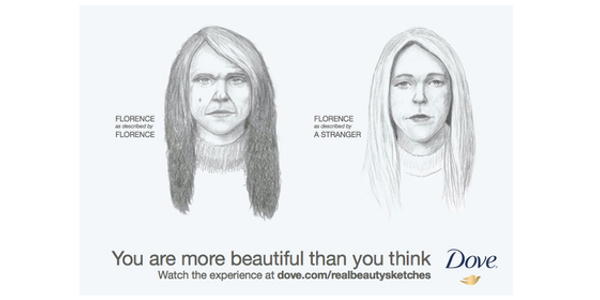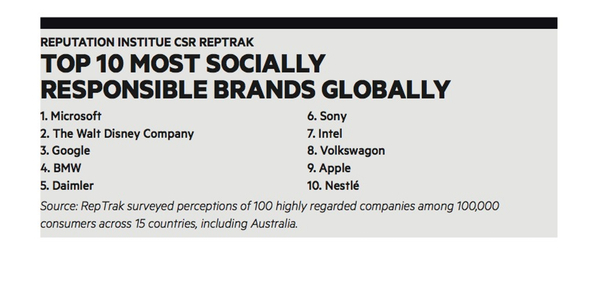Repositioning value: making what’s good for the world good for business
Share
Creating shared value between business and society is the next step for social responsibility and could be the new frontier for branding, writes Chris Byrne.
Corporate social responsibility (CSR) is no longer a nice-to-have department; it’s front and centre of brand strategy and core to business. These are the words of Adland titan, Sir Martin Sorrell, signifying how important what was once considered a sideline reputation-building tactic has become. But, as CSR emerges as a guiding principle among leading brands, it’s evolving into something new. Academics Michael Porter and Mark Kramer sum up this evolution in their discussion-defining article – ‘Creating Shared Value’ (CSV) – introducing the concept of creating economic value in a way that also creates value for society by addressing its needs and challenges.
Capitalism and trust in business is broken, Porter and Kramer argue, due to a narrow focus on creating short-term value for business, rather than long-term, sustainable value shared among the community that supports it.
With the exception of a few frontrunners, the principle of CSV remains on the periphery
of business strategy, at a time when trust in corporations sits at an all-time low and difficulty differentiating brands in crowded marketplaces reaches an all-time high. A lack of frameworks for what is a relatively new concept is proving a barrier to its development, as are challenges in communicating to sceptical consumers with short- attention spans. Mixed levels of understanding is also stifling growth of the principle.
CSR versus CSV
CSV is still nascent, and an agenda most marketing managers are yet to engage with, according to Fuji Xerox Australia’s APAC head of sustainability, Amanda Keogh. “CSV is a new concept – a new language coming through the sustainability area,” she says. However, many companies are already gaining competitive advantage through CSV, Keogh adds.
“In Australia, there is a healthy competition within industries to stand out from the crowd on the basis of sustainability leadership.”
The concept is more than social responsibility, philanthropy or even sustainability, Porter and Kramer argue. It recognises that societal needs (not just conventional economic needs) define markets that social harms or weaknesses frequently create internal costs for firms and that addressing societal harms and constraints won’t necessarily raise costs for firms if they can innovate through new technology, operating methods, and management approaches.
The big difference between the two acronyms for Hugo Verkuil, vice president of marketing and managing director, food and refreshment, at Unilever Australia, is that CSV is ingrained in everything an organisation does. “From the drive to innovate in a way that is sustainable, all the meetings we have, be they innovation or a logistics meeting, there is always a check-off on ‘is it helping to be sustainable?’ Once you have that culture, it naturally flows into your culture and campaigns.”
Sustainability is a natural starting point for many CSV initiatives as firms find value in reducing their impact on the planet while streamlining processes like production and packaging. The pay-off to business from CSV can come in many different forms. Positive brand position, cost savings or even internal marketing goals such as attraction and retention of talent. For the Coca-Cola Company, value is being found in acknowledging the problem of obesity and providing healthier drink options. Unilever’s Dove drew favourable positioning from its ‘Real Beauty’ campaign by promoting a balanced view of body image.

Patagonia takes a long-term view of conservation to help preserve the outdoors, even going so far as to encourage the purchase of its products second-hand. Fuji Xerox Australia’s Eco Manufacturing Centre has delivered a $240 million return on a $21 million investment, by recovering almost all products and associated consumables at end of life.
Traditional CSR was seen as giving back or philanthropy, and operated alongside core business. CSV turns that on its head by integrating social good into the core, and is more deeply rooted in ROI. “By definition, something that is creating shared value will be generating return on investment from a financial perspective,” CSR partner at PwC, Mark Reading, observes. “Something doesn’t create shared value unless it genuinely creates societal value and economic profit for shareholders.”
However, there is a lot that CSV doesn’t address and it cannot simply replace CSR, Keogh adds. “CSR isn’t just about community and environmental impact; it’s about questions of social justice and social equity. It deals with issues like corruption. There is a place for both.”

Getting the message across
It’s all well and good to have social value initiatives in place, but getting the message through to sceptical and distracted consumers is another challenge altogether. Kasper Ulf Nielsen, executive partner of the Reputation Institute, believes companies aren’t communicating programs in a clear and meaningful way and engage in too many programs that are irrelevant to their stakeholders.
The consultancy’s yearly reputation study found only five percent of companies are perceived to be delivering on CSR programs, a drop of 12 percent from 2012. The global survey, which ranks top performers, lists The Walt Disney Company, BMW and Google
as leaders, but places global sustainability forerunner Unilever 65th due to low consumer understanding of its programs across the 15 markets covered.
“What we’ve got here is a failure to communicate,” Nielsen says. “Consumers perceive incorrectly or fail to recognise what organisations do… they feel for many businesses, social responsibility is simply a public relations campaign in disguise, and that the majority of companies do not act in the best interests of the community and environment despite the fact that they spend upwards of $50 to 100 million per year on CSR programs.”
Edelman’s global Trust Barometer also highlights a growing distrust in business. Globally, trust in business to do what is right sits at 50 percent, while trust in business leaders to tell the truth languishes at 18 percent.
Keogh acknowledges the scepticism companies face in positioning social value as more than a PR campaign. “In the past, you have issues of ‘greenwash’… companies have overstated claims, which has led to a healthy scepticism as to what the true credentials of a product are.
“When it comes to communicating sustainability and CSV, companies need to be very careful to provide a balanced account, talk openly about what could be working well with their programs and where they see opportunities to improve.”
Verkuil believes consumers, particularly young, connected generations, desire social responsibility in a brand. “What we increasingly see in the culture of consumerism is consumers want to make a difference, but don’t know how or think their impact is just a drop in the ocean. Through our brands and bringing this all together, consumers feel they’re part of a movement and that they can really contribute.”
Believability aside, there’s a general consensus that if a company’s social value efforts are considered genuine, the benefits are tremendous. “We live in a reputation economy,” Nielsen says. “We operate in a marketplace where who you are means more than what you sell.
“Almost half of people’s willingness to trust, admire and feel good about a company is based on their perceptions of the CSR of the company, so this is a key tool for companies to use to improve support from stakeholders like consumers, regulators, financial community and employees.”
The Reputation Institute’s study found almost three in four consumers are willing to recommend companies perceived as socially responsible, while only 31 percent would do so for companies that aren’t.
Having a purpose that resonates with customers is the first step in getting consumers to listen and appreciate a social value story. “Consumers are increasingly looking for brand preference driven by more meaningful things, driven by more than just what the product does,” Verkuil believes. “Will it persuade consumer [decision-making]? Given that motivations of consumers are increasingly about trust, understanding and purpose, it is part of the brand identity that consumers identify with.”
Differentiation
As the fight for share of wallet is exhausted on the grounds of product and price, purpose is becoming the next big differentiator. Keogh puts it well: “In increasingly competitive and commoditised markets, it’s very hard to differentiate your brand against others. Sustainability and the creating shared value agenda allows organisations to talk meaningfully about their purpose. Having a story in this area and being able to tie what you do as a company with solving social and environmental problems is tickets to the game… the more compelling your story, the greater the differentiator.” But CSV is more than just the next battleground to turn to once all other boxes are ticked. It’s a branding mentality that can unlock powerful positioning opportunities. Outgoing global CEO of communications group Havas, David Jones, agrees: “The most successful companies in the future will out-behave their competition… the next Apple will come from and will do to social responsibility what Apple did to design.”
Businesses that can create value in the same way Apple did by leading consumer needs, while delivering something of social value, stand to build a purpose and brand as strong as Apple. “The essence of strategy is choosing a unique positioning and a distinctive value chain to deliver on it,” Porter and Kramer write. “Shared value opens up many new needs to meet, new products to offer, new customers to serve and new ways to configure the value chain. The competitive advantages that arise from creating shared value will often be more sustainable than conventional cost and quality improvements. The cycle of imitation and zero-sum competition can be broken.”
Hitting the sweet spot
The search for the sweet spot between social or environmental need and business goals is the next innovation journey for many brands. According to Porter and Kramer, there are three key areas to look into in order to find a match between business strengths and social problems:
Re-conceiving products and markets: identify societal needs, benefits and harms that are or could be embodied in the firm’s products. Opportunities constantly change as technology evolves, economies develop and societal priorities shift. Ongoing exploration can lead to discovery of new opportunities for differentiation and repositioning in traditional markets, as well as uncover new markets.
Redefining productivity in the value chain: a company’s value chain is tied to issues like natural resource and water use, health and safety, working conditions and so on. Opportunities to create shared value arise because societal problems can create economic costs in the firm’s value chain. These ‘externalities’ inflict internal costs on the firm. For example, excessive packaging of products is not just costly to the environment, but costly to the business.
Building supportive industry clusters at the company’s locations: productivity and innovation are strongly influenced by ‘clusters’ – the partners and infrastructure situated in the business’ vicinity. Firms can create shared value by building clusters
to improve company productivity, while addressing gaps or failures in conditions surrounding the cluster. Addressing deficiencies in areas such as logistics, suppliers, distribution channels, training, market organisation and education can be of benefit to business. Focusing on the weaknesses that represent the greatest constraints to the company’s own productivity and growth, and addressing areas the company is best equipped to influence, can create shared value.
“People finally understand that if you improve the lot of your stakeholders and you’re in the business of building brands and products and services, which we are, for the long-term, doing good is good business,” Sorrell says, concluding his thoughts on social value marketing.
Brands that find ways to create shared value, which builds a platform for differentiation, stand to gain competitive advantage. Business involving a social purpose that enables society to improve, while allowing companies to grow, can create a positive cycle of shared prosperity, leading to markets that endure and brands that may last the test of time.















